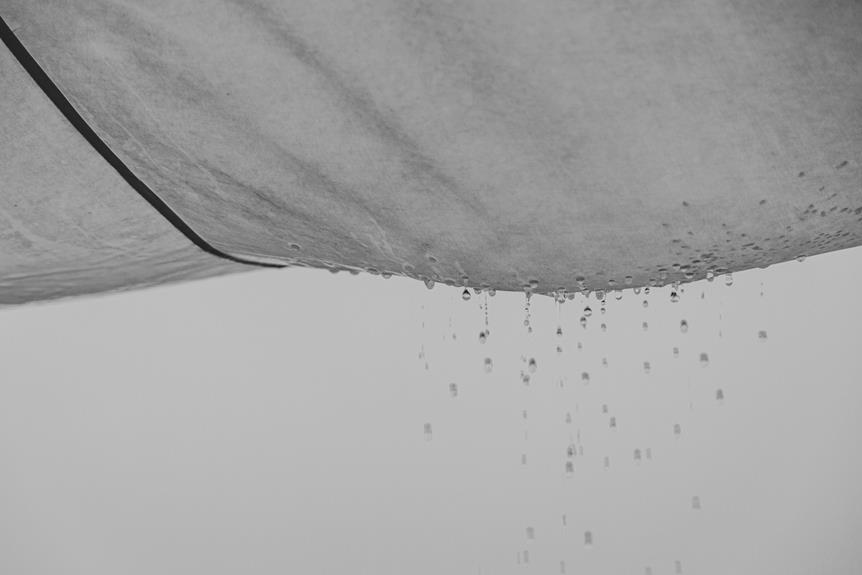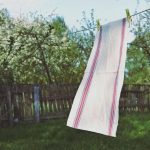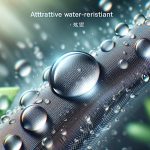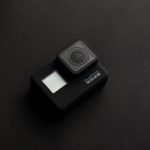When you're gearing up to waterproof fabrics for rain gear, it's crucial to understand the basics of the materials you're working with. Choosing the right fabric, such as nylon or Gore-Tex, sets the foundation for effective protection against the elements. You'll also need to prep your fabric properly and apply the right waterproofing treatments to enhance its capabilities. But what specific steps should you take to ensure long-lasting effectiveness? The answer lies in a few essential techniques that can make all the difference.
Table of Contents
Key Takeaways
- Choose the right waterproofing method, such as DWR finishes or membranes, based on the fabric type and expected weather conditions.
- Properly prepare fabrics by washing them with gentle detergent and ensuring they are clean and dry before applying waterproof treatments.
- Use spray-on or wash-in waterproofing treatments suited for your gear, following specific application instructions for even coverage.
- Regularly maintain waterproofed fabrics by cleaning them and reapplying treatments based on usage and environmental exposure.
Understanding Waterproofing Basics
To effectively waterproof fabrics, it's essential to understand the different methods and materials that can shield your textiles from moisture. Waterproofing is about creating a barrier that prevents water from penetrating the fabric while still allowing it to breathe. This balance is crucial, especially for outdoor gear.
One common method is applying a durable water repellent (DWR) finish. This chemical treatment creates a protective layer on the fabric's surface, causing water to bead up and roll off.
You might also encounter laminated fabrics, which involve bonding a waterproof layer to the textile. This method provides excellent protection but can reduce breathability.
Another approach involves using membranes, which are thin sheets of waterproof material that allow moisture vapor to escape. These are often found in high-performance gear. Understanding these basic methods will help you assess what works best for your needs.
Lastly, always consider the environment. For instance, heavy rain may require more robust treatments than light drizzle. By grasping these waterproofing basics, you'll be better equipped to choose the right techniques when preparing your fabrics for the elements.
Choosing the Right Materials
When selecting materials for waterproofing, consider how their properties align with your specific needs and the conditions they'll face. You'll want to ensure that your chosen fabric not only repels water but also offers breathability and durability. Here's a quick overview of some materials you might consider:
| Material | Pros | Cons |
|---|---|---|
| Nylon | Lightweight, durable | Can absorb moisture if not treated |
| Polyester | UV resistant, quick-drying | Less breathable than nylon |
| Gore-Tex | Excellent waterproofing | More expensive |
| PVC | Completely waterproof | Heavy and less flexible |
| Softshell | Comfortable, stretchy | Less waterproof than hardshell |
As you evaluate these options, think about the balance between waterproofing, breathability, and comfort. For example, if you're facing heavy rain, a Gore-Tex fabric might be your best bet. For lighter, more flexible needs, a softshell could suffice. Always prioritize the conditions you expect to encounter, so you stay dry and comfortable while enjoying your outdoor adventures.
Prepping Your Fabrics
Preparing your fabrics for waterproofing involves cleaning them thoroughly to remove any dirt, oils, or residues that could interfere with the treatment process. This step is crucial, as leftover contaminants can prevent the waterproofing agent from adhering properly to the fabric.
Here's how you can prep your fabrics effectively:
- Wash the Fabrics: Use a gentle detergent and wash your fabrics according to the care instructions. Avoid fabric softeners, as they can leave a residue that hinders waterproofing.
- Rinse Thoroughly: Make sure to rinse the fabrics well to remove any soap residue. Any leftover detergent can affect the waterproofing treatment, so this step is vital for achieving optimal results.
- Dry Completely: After washing, let your fabrics dry completely. If possible, air-dry them in a well-ventilated area. This ensures that moisture won't interfere with the waterproofing process later on.
Applying Waterproofing Treatments
When it comes to applying waterproofing treatments, choosing the right products is key.
You'll want to consider various application techniques that suit your fabric type.
Let's explore how to make your fabrics water-resistant effectively.
Choosing Waterproofing Products
Selecting the right waterproofing product is crucial for ensuring your fabrics stay dry and durable. With so many options available, it's essential to choose a product that suits your specific needs. Consider the type of fabric you're treating and how much exposure it'll face to water and weather elements.
Here are three popular types of waterproofing products to consider:
- Spray-On Treatments: These are easy to apply and work well for quick fixes. They're great for jackets and gear that need a refresh without a full wash.
- Wash-In Treatments: Ideal for fabrics that can withstand a washing machine cycle, these treatments penetrate deeply and provide long-lasting protection. They're perfect for items like tents or backpacks.
- Liquid Coatings: These are designed for heavy-duty applications and are ideal for outdoor gear subjected to extreme conditions. They often require more careful application but offer superior waterproofing.
Application Techniques Explained
Applying waterproofing treatments correctly ensures your fabrics achieve optimal water resistance and longevity.
Before you begin, make sure your fabric is clean and dry. For spray-on treatments, hold the can about 6–8 inches away from the surface. Apply an even coat, ensuring you cover all areas, especially seams and edges, which are prone to water penetration.
If you're using a wash-in treatment, follow the manufacturer's instructions for dosage and water temperature. Typically, you'll add the treatment to your washing machine during the rinse cycle, allowing the fabric to absorb the waterproofing agent fully.
After application, let the fabric dry completely, either air-drying or using a low-heat setting in the dryer, depending on the treatment's guidelines. This step is crucial, as it helps the treatment bond with the fabric fibers.
Maintaining Waterproofed Fabrics
To keep your waterproofed fabrics in top condition, regularly clean them according to the manufacturer's instructions. This ensures that dirt, oils, and other contaminants don't compromise their waterproof properties. When washing, always use a gentle detergent, as harsh chemicals can damage the waterproofing layer.
Here are three essential maintenance tips to follow:
- Avoid Fabric Softeners: Fabric softeners can block the pores in waterproof fabrics, reducing breathability and water resistance. Stick to detergents recommended for technical fabrics.
- Air Dry: Instead of using a dryer, air-dry your waterproof gear. High heat can damage the waterproof coating and cause it to peel or crack. Hang your items in a well-ventilated space away from direct sunlight.
- Reapply Waterproofing Treatments: Over time, the waterproofing may degrade. Depending on the fabric, you might need to reapply a waterproofing treatment. Check the manufacturer's recommendations for the best products to use.
Tips for Long-Lasting Protection
Consistently following a few simple practices can significantly extend the life of your waterproof fabrics and maintain their protective qualities.
First, always clean your gear after exposure to dirt, salt, or oils. Use a gentle detergent specifically designed for technical fabrics, as harsh chemicals can compromise waterproofing.
Next, regularly reapply a waterproofing treatment according to the manufacturer's recommendations. This helps restore the fabric's water-repellent finish.
When storing your gear, keep it in a cool, dry place, away from direct sunlight to prevent damage.
Avoid unnecessary wear by not overloading pockets or putting excessive stress on seams and zippers. Additionally, be cautious around sharp objects and abrasive surfaces that could puncture or scratch the fabric.
If you notice your gear losing its waterproof qualities, don't wait too long to address it; act quickly to re-treat or repair.
Lastly, check your gear for any signs of damage before each use and repair any minor issues promptly to prevent them from worsening.
Frequently Asked Questions
Can I Waterproof Already Wet Fabrics?
You can't effectively waterproof already wet fabrics. First, let the materials dry completely. Once they're dry, you can apply a waterproofing treatment to ensure protection against future moisture and keep your gear in top condition.
How Often Should I Reapply Waterproof Treatments?
You should reapply waterproof treatments every few months or after several washes. Regularly inspect your gear, and if water no longer beads on the surface, it's time to refresh the treatment for optimal performance.
What Are Signs of Fabric Waterproofing Failure?
You'll notice signs like water soaking through, spots appearing on the fabric, or a sticky residue. If your gear feels damp inside after use, it's likely time to reassess the waterproofing treatment.
Are Homemade Waterproofing Solutions Effective?
Homemade waterproofing solutions can be effective, but their success varies. You'll need to choose the right ingredients, apply them properly, and test the fabric afterward to ensure it meets your waterproofing expectations.
Can Waterproofing Affect Fabric Breathability?
Yes, waterproofing can affect fabric breathability. When you apply treatments, they often create a barrier that restricts airflow, which can lead to discomfort. You'll want to balance waterproofing with breathability for optimal performance.
- What Is Pochampally Ikat? a Journey to India’s Silk City - June 27, 2025
- What Is Pochampally Ikat? a Journey to India’s Silk City - June 27, 2025
- What Is Pochampally Ikat? a Journey to India’s Silk City - June 27, 2025







